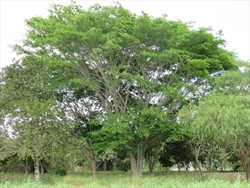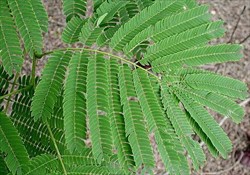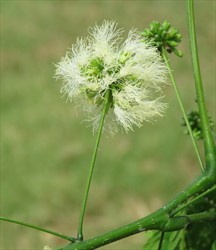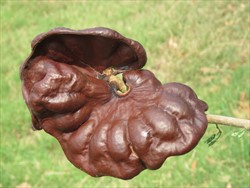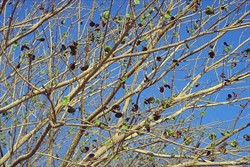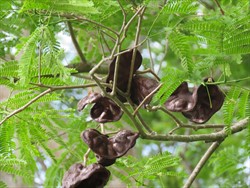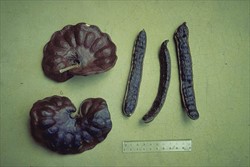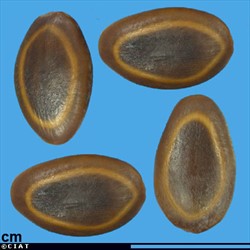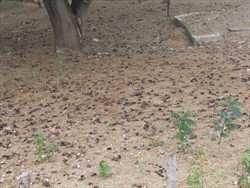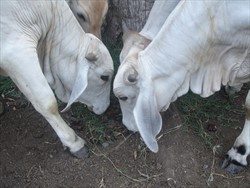Tropical Forages
Basionym: Mimosa cyclocarpa Jacq.; Inga cyclocarpa (Jacq.) Willd.
Family: Fabaceae (alt. Leguminosae) subfamily: Caesalpinioideae (mimosoid clade*) tribe: Ingeae.
* Azani, N. et al. [97 authors from 54 institutions] 2017. A new subfamily classification of the Leguminosae based on a taxonomically comprehensive phylogeny. Taxon 66: 44–77.
A semi-deciduous tree up to 40 m; crown thin and spreading, leaves bipinnately compound with 4‒9 pairs of pinnae, each with 13‒30 pairs of leaflets, narrowly oblong, 8‒13 mm long, 2‒4 mm wide. Inflorescence a many flowered, compact and round head, white, 1‒2.5 cm diameter, on a 2‒3 cm long peduncle, at the base of the leaves. Pod flat, thickened, contorted and indehiscent, resembling an ear in form, reddish-blackish-brown, 7‒12 cm in diameter, 0‒16 seeds/pod; seed 13‒20 × 11 × 8 mm, ovate, with pale pleurogram. 1,000‒3,000 seeds/kg.
Asia: 象耳豆 xiang er dou (Chinese); sengon buto (Indonesia)
Caribbean: bwa tanis wouj (Creole Patois)
English: devil's-ear, earpodtree, elephant's-ear, Mexican walnut, monkey ear, monkeysoap, mulatto ear, pitchwood
Europe: bois tanniste rouge, caro, oreille d'éléphant, oreille de singe (French); Affenseife (German)
Latin America: tubroos (Belize); genicero, jarina, kurú (Costa Rica); pit (Guatemala); petz'k'in, pich, piich (Maya); tuburus (Nicaragua); algarrobo de orejas, anjera, árbol de las orejas, carita, caro caro, caro hembra, cascabel, cascabel sonaja, conacaste, corotú, costa-mahogany, dormilón, flamboyan extranjero, guanacaste, guantarabacke, hueso de pescado, jenizaro, juana, nacastillo, nacastle, nacaztle, oreja, oreja de judio, oreja de mono, orejón, parota, perota, picho, piñón, yaga chibe (Spanish); chimbo (Brazil)
Northern America: Mexico (Chiapas, Colima, Guerrero, Jalisco, Mexico, Michoacán, Nayarit, Oaxaca, San Luis Potosí, Sinaloa, Tamaulipas,Veracruz)
Central America: Belize, Costa Rica, El Salvador, Guatemala, Honduras, Nicaragua, Panama
South America: Brazil (Roraima), Colombia, Guyana, Venezuela (Apure, Zulia, Aragua, Barinas, Cojedes, Falcón, Guárico, Miranda, Nueva Esparta, Portuguesa, Federal District, Carabobo, Lara, Yaracuy)
Cultivated/naturalized:
Africa: humid and subhumid tropical
Asia: China, India, Philippines, Singapore
Pacific: New Caledonia
Caribbean: Barbados, Cuba, Dominica, Haiti, Jamaica, Martinique, Montserrat, Puerto Rico, St. Lucia
South America: Suriname (?)
Forage
Pods are readily eaten by grazing livestock and/or collected to be fed as sugar-rich supplement. The leaves are eaten but less readily than the pods. Although there are reports on E. cyclocarpum foliage being used as forage, the main forage/livestock-related value of this tree lies in the fact that it provides (1) highly nutritious pods in the dry season, (2) shade and shelter to grazing livestock and (3) improved pasture growth under its canopy. In its area of origin, it is frequent as a spontaneous tree component in pastures, often in association with Samanea saman.
Other
In agroforestry, including silvopastoral systems, provision of shade and wood. The wide spreading crown provides excellent shade for livestock as well as for crops such as coffee. Immature pods can be used as vegetables after cooking; have nutritional and medicinal properties.
Soil requirements
Tolerant of alkaline, calcareous and acid soils with pH as low as 5 if aluminium saturation is not a problem. Best growth on medium-textured soils; however, eroded ultisols, deep moist clays, shallow sandy clays and porous limestone soils are reported to also support good growth. Intolerant of water-logging.
Moisture
Native habitat is dry forest vegetation with dry seasons of up to 6 months; mean annual rainfall: 750‒2,500 mm.
Temperature
Is found in mean annual temperature ranges of 23‒28 °C at elevations between sea level and 1,200 m asl. Intolerant of frosts.
Light
Intolerant of shade.
Reproductive development
Flowering occurs when the trees are leafless (towards the end of the dry season); one year from flowering to mature pods.
Defoliation
Reported to resprout vigorously after coppicing or lopping. Pruning can improve the length and form of the bole.
Fire
No information available but adult trees will probably resprout if fires are not too hot.
Guidelines for establishment and management of sown forages.
Establishment
For plantation establishment, 4 × 4 m spacings are recommended, with thinnings, on a rotation of 25‒35 years. Thorough weeding of the plantation is essential during the early years.
Fertilizer
No data available but trees are probably responsive to fertilisation. Due to symbiotic nitrogen fixation, generally improved grass growth below E. cyclocarpum trees can be observed in silvopastoral systems.
Compatibility (with other species)
Once established, most suitable as tree component in silvopastoral systems.
Companion species
Once established, combines well with any grass or legume.
Pests and diseases
No widespread or serious disease or pest problems are reported.
Ability to spread
Spread by animals that ingested pods with mature seeds.
Weed potential
Minor.
Nutritive value
Mature pods: 16.3‒26.3% CP, 60‒76% digestibility; leaves: 21.3% CP, NDF 60.7%.
Palatability/acceptability
Pods are highly palatable to all livestock. Information on the palatability of foliage is, however, controversial. Whereas there seem to be situations where leaves are actually consumed, palatability of E. cyclocarpum foliage is considered to be very low.
Toxicity
A series of antinutritional factors, among them saponins, trypsin inhibitors and cyanogenic glycosides, have been reported.
Feedipedia link
Dry matter
Not applicable.
Animal production
Depending on the level of supplementing with E. cyclocarpum pods, reported increases of gains of cattle or sheep liveweights as well as milk production seem to be only modest.
2n = 26.
In silvopastoral systems, pod production is allegedly 3‒10 times higher than that of any other tree. Adult trees produce about 2,000 pods/season, each with 10‒16 seeds. Seed storage behaviour is orthodox; seeds tolerate desiccation to 10.7%. Seeds remain viable for several years under cool, dry conditions.
No information available.
- Multipurpose use.
- Wide adaptability (soil, rainfall).
- Highly nutritious pods.
- Low palatability foliage.
- Slow establishment.
Faridah Hanum, I. and van der Maesen, L.J.G. (1997) Enterolobium cyclocarpum (Willd.) Griseb. In: Faridah Hanum, I. and van der Maesen, L.J.G. (eds) Plant Resources of South-East Asia No. 11. Auxiliary Plants. Backhuys Publishers, Leiden, the Netherlands. p. 280. edepot.wur.nl/411331
Hernández, I. and Sánchez, M.D. (2014) Small ruminant management and feeding with high quality forages in the Caribbean. Interamerican Institute of Cooperation in Agriculture (IICA), Santo Domingo, Dominican Republic. repositorio.iica.int/bitstream/11324/2611/1/BVE17038698i.pdf
NFTA. (1994) Enterolobium cyclocarpum: the ear pod tree for pasture, fodder and wood. NFTA Highlight 94-02. Nitrogen Fixing Tree Association, Waimanalo, HI, USA. bit.ly/2UWEEGu
None released.
None reported.
